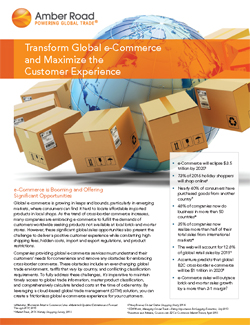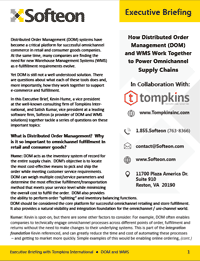Readers Respond - Irrational Shipping Prices and the Demise of Brick and Mortar Retail
A couple of months ago, I penned what I thought was a pretty provocative First Thoughts column that basically argued this: retailers are in effect complicit - albeit forced to behave that way by Amazon - in the on-going woes of brick and mortar retail by the way they are handling the costs of efulfillment. (See Irrational Shipping Prices and the Demise of Brick and Mortar Retail.)
I wrote then the following: "Here in 2017, the free/highly discounted shipping policies of Amazon, other retailers, and even UPS itself is accelerating the demise of brick and mortar retail at a faster rate - perhaps much faster - than would otherwise be the case. This is an incredibly important point."
I added that "In other words, is the growth of ecommerce - and major financial woes in some but not all sectors of brick and mortar retail - something of a fraud, based on irrational shipping charges by virtually everyone in the market.'
| GILMORE SAYS: |
I will add that I am not talking about the true demise of brick and mortar retail, but rather a far different and smaller physical store presence.
WHAT DO YOU SAY?
Send us your
Feedback here
|
In the end, I said this: "The simple reality is that in most cases, the in-store price should in fact be lower than the on-line price," even though most retailers try to have the same prices across channels, or in some cases actually sell some goods on-line for less.
I more recently wrote another column when Walmart seemed to validate my point, announcing it was going to offer product price discounts for items ordered on-line and picked up in store, versus being shipped to a customer's home. (See Ha! Walmart Proves Me Right on eFulfillment.)
Also recently, both UPS and FexEx have announced they are raising rates for ecommerce deliveries and getting tough on peak season forecasts, which will put more pressure on etailers to reduce free/discounted shipping. We'll see. They may just take it in the P&L some more. Japanese parcel carriers are also sharply increasing ecommerce shipping charges.
All that led to a large number of email comments, both directly from SCDigest readers and indirectly from our partner RetailWire, which published a condensed version of my first piece.
So I am basing this column on highlights of that feedback. Let's get right to it.
A handful of readers said my perspective was off, summarized well by this comment from reader Mark Johnston, who wrote "I understand the point you are making, that shipping costs are built into the in-store price but are not being built into the ecommerce prices yet. However, there are other brick and mortar costs (facilities, rent, equipment, labor, etc) that need to be built into an in-store price - many of these represent costs that ecommerce avoid completely. To me, these costs are material, and comprise the basic essence of why ecommerce is winning."
Along similar lines, Gene Detroyer, a professor at the European School of Economics, wrote that "Of course shipping is not free, but it replaces the various in-store costs the retailer experiences. When a customer goes into a brick-and-mortar store they don't see charges for rent and labor added to the price of the product. Shipping is a substitute for those store elements."
I think there is some merit in that critique, and need to ponder on it some more, but for now will just say that in general retailers price their goods in a way that delivers a profit from brick and mortar sales, whereas most, including Amazon, make little profits or have losses in ecommerce operations, in large part due to distribution and shipping costs. So there is something not right in the end about this perspective.
Most of the Feedback, however, agreed with my viewpoint.
"Great article by Dan Gilmore, I think he's spot on with his commentary," wrote reader John Antonucci of 721 Logistics, adding that "It will interesting to see how things play out with Amazon and its quest to dominate the world's global supply chain. When does it stop or does it ever stop? Will the success/failure continue to be investor driven, consumer driven or both?"
Reader Mark Reade of the Chicago area commented that "I believe Gilmore is absolutely correct that the growth of ecommerce would be far less if merchants charged what their costs are for shipping, maybe far less - and think how that would change the current dynamic. But given what Amazon is doing, with Walmart and others following suit, retailers are simply in a very tough bind indeed."
Well said.
A number of readers believe that there will be some shakeout eventually, and when Amazon and others get to the end of that, more realistic costs for shipping will indeed be levied.
For example, Ken Lonyai of ScreenPlay InterActive wrote that "The dot-com bubble was heavily fueled by customer acquisition at all costs. Since then, Amazon and others have been acquiring customers at a lesser cost and that investment/cash flow has sustained, enabling them to slowly and steadily habitualize customers to e-commerce shopping. Help from carriers in the form of discounts also makes the strategy possible."
He then added that "One day however, when physical retail is damaged enough, the market conditions allow it and the desire for bigger profits is vocal enough, "free shipping" is certain to be reflected in pricing that exhibits the true costs of e-commerce."
The question of course, is just how far away that day is – and what traditional retail looks like when we get to the other side.
Along a similar vein, Ricardo Belmar of InfoVista wrote that "Can free shipping be sustained? With current accounting models, no. Not long term. Even for Amazon. I suspect, as cost structures are adapted to the new era."
 But Belmar added these interesting thoughts: "Every product is shipped - either to a customer's home, or to a store. What changes is how the cost is allocated and accounted for. Retailers need to adapt their models as they migrate to a unified commerce view of their customer, their merchandise, and their business as a whole. Claiming to be omnichannel while continuing to model costs in multiple silos will not lead to success in the long term." But Belmar added these interesting thoughts: "Every product is shipped - either to a customer's home, or to a store. What changes is how the cost is allocated and accounted for. Retailers need to adapt their models as they migrate to a unified commerce view of their customer, their merchandise, and their business as a whole. Claiming to be omnichannel while continuing to model costs in multiple silos will not lead to success in the long term."
I will also add comments from Craig Sundstrom of Weisner Steel, who wrote "What a bizarre notion that we're talking, even if only half-seriously (at least I hope not fully seriously) about the possibility of "the demise of brick/mortar retail" before we consider the more obvious possibility: when will shipping practices become rational and "free shipping" disappear?"
That of course is the critical question. I will add that I am not talking about the complete demise of brick and mortar retail, but rather a far different and smaller physical store presence - just look at the number of closings already this year, in a decent if obviously not great economic environment. What will happen in the next recession to the retail footprint?
Finally for this week, a consultant who wished to remain anonymous emailed me with these comments: "No one has laid out the issues as succinctly or completely as you have here. Excellent work - caused me and others here at the company to have a very interesting discussion about your perspective."
Thank you. He added "We think it all comes down into the end of the stock market valuations for Amazon most notably, but also to an extent Walmart and a few others. If the stock price of Amazon was ever to get hammered from its lack of profitability (though clearly with incredible growth), then it might have to rethink its approach to logistics costs. But that's is a long ways away from retailers being "Amazoned" in the here and now."
So there you have it - good stuff. We will publish the full texts of these comments and others in coming weeks right here in this newsletter. Would love some more thoughts from readers on all this.
Do you agree with Gilmore's analysis - or not? What would happen if retailers actually charged what it costs to pick, pack and ship ecommerce orders? Do you think after a shakeout they will do so in the end? Let us know your thoughts at the Feedback button below.
|



![]()
![]()

![]()
![]()








 But Belmar added these interesting thoughts: "Every product is shipped - either to a customer's home, or to a store. What changes is how the cost is allocated and accounted for. Retailers need to adapt their models as they migrate to a unified commerce view of their customer, their merchandise, and their business as a whole. Claiming to be omnichannel while continuing to model costs in multiple silos will not lead to success in the long term."
But Belmar added these interesting thoughts: "Every product is shipped - either to a customer's home, or to a store. What changes is how the cost is allocated and accounted for. Retailers need to adapt their models as they migrate to a unified commerce view of their customer, their merchandise, and their business as a whole. Claiming to be omnichannel while continuing to model costs in multiple silos will not lead to success in the long term."

